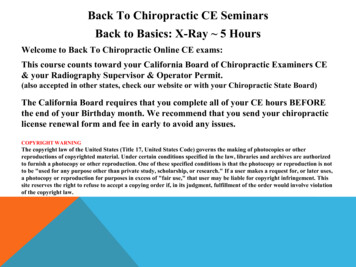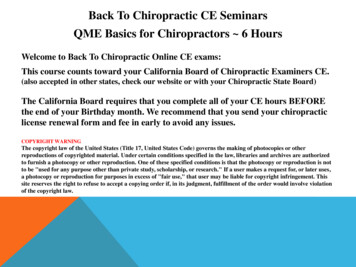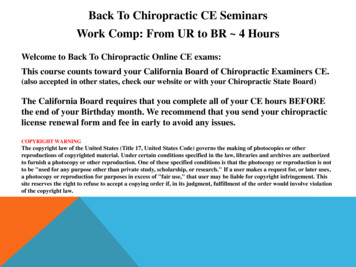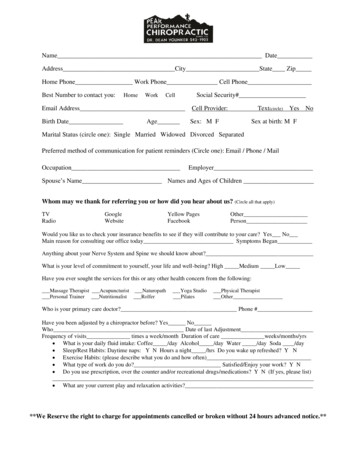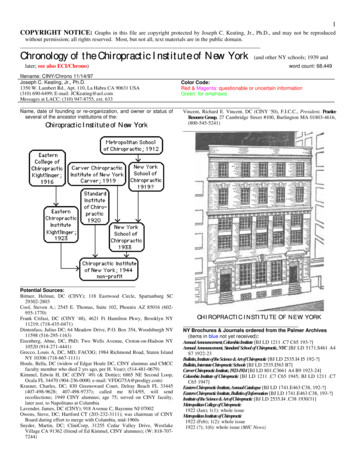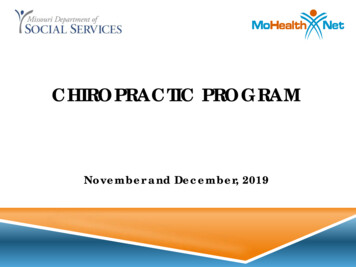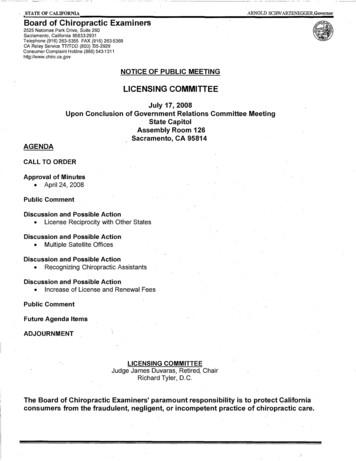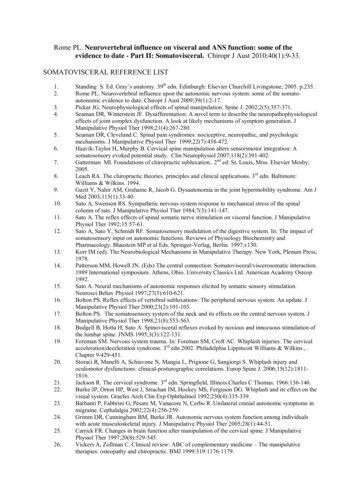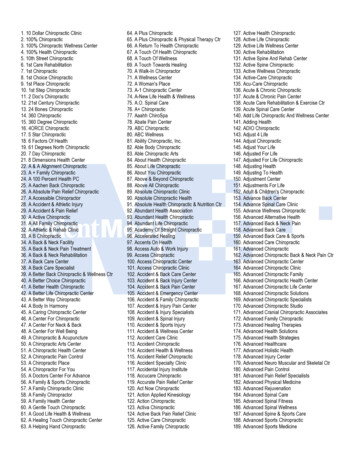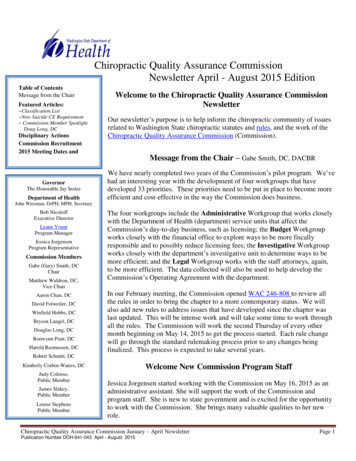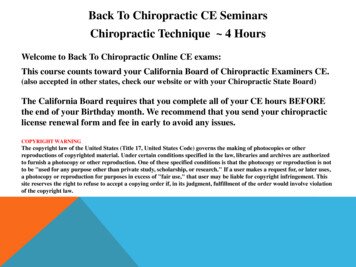
Transcription
Back To Chiropractic Continuing Education SeminarsPhysiotherapy 6 HoursWelcome:This course counts as 6 Hours of CE for Physiotherapy for the Chiropractic Board ofExaminers for the state of California.There is no time element to this course, take it at your leisure. If you read slow or fastor if you read it all at once or a little at a time it does not matter.
How it works:1.Helpful Hint: Print exam only and read through notes on computer screen and answer as you read.2.Printing notes will use a ton of printer ink, so not advised.3.Read thru course materials.4.Take exam; e-mail letter answers in a NUMBERED vertical column to marcusstrutzdc@gmail.com.5.If you pass exam (70%), I will email you a certificate, within 24 hrs, if you do not pass, you mustrepeat the exam. If you do not pass the second time then you must retake and pay again.6.If you are taking the course for DC license renewal you must complete the course by the end ofyour birthday month for it to count towards renewing your license. I strongly advise to take it wellbefore the end of your birthday month so you can send in your renewal form early.7.Upon passing, your Certificate will be e-mailed to you for your records.8.DO NOT send the state board this certificate.9.I will retain a record of all your CE courses. If you get audited and lost your records, I have a copy.
The Board of Chiropractic Examiners requires that you complete all of your required CE hoursBEFORE you submit your chiropractic license renewal form and fee.NOTE: It is solely your responsibility to complete the course by then, no refunds will be given for lackof completion.Enjoy,Marcus Strutz DCCE ProviderBack To Chiropractic CE SeminarsCOPYRIGHT WARNINGThe copyright law of the United States (Title 17, United States Code) governs the making of photocopies or other reproductions of copyrighted material.Under certain conditions specified in the law, libraries and archives are authorized to furnish a photocopy or other reproduction. One of these specifiedconditions is that the photocopy or reproduction is not to be "used for any purpose other than private study, scholarship, or research." If a user makes arequest for, or later uses, a photocopy or reproduction for purposes in excess of "fair use," that user may be liable for copyright infringement.This site reserves the right to refuse to accept a copying order if, in its judgment, fulfillment of the order would involve violation of the copyright law.
Back To ChiropracticCE Seminars PhysiotherapyPresented byMarcus Strutz, DC
Marcus Strutz, DCLife Chiropractic College West GraduateJune 1996, Summa Cum LaudeProfessor Life Chiropractic College West, 1997-2002 Spinal Biomechanics (authored course manual) Physiotherapy Rehab (authored course manual) Physiotherapy Modalities (authored course manual) X-Ray Physics (authored course manual) Philosophy I Philosophy V - Practice Management Microbiology Lab Systemic Physiology Lab5
Private Practice, 2000-present Mendocino/Ft Bragg, CA CE Seminars, 2002-present:Technique, Wellness (Pt Ed), Physiotherapy,History Taking & Physical Examination Procedures Ghost Writer Practice Management, 2007-present National Board Review Instructor, 1999-2000Dr. Irene Gold & Dr. John Donofrio Middle School Teacher Math & Science, 1989-1993 Racquetball Club Pro & Weight TrainerWalnut Creek, 1982-1987 Father: Amuel Strutz DC Palmer Grad 196156
Macro vs Micro TraumaIn The Beginning In the DC’s office you typically get two types of cases,macro-trauma (think hit by a bus) or the dreaded repetitivemicro-trauma (RMT). For the typical DC office 90-99% ofnew patients likely present with RMT instead of macro-trauma,but we shall consider both.For this course I will assume that visceral and systemicpathology have already been ruled out and that we are dealingwith classic acute and chronic soft tissue injuries.7
Macro vs Micro TraumaPt’s understand macro-trauma. In fact for many pts it is the onlypossibility they consider. Most pt’s believe that they can onlyget hurt from a specific incident. It is the RMT that providesconfusion. Simple acts of daily living over a long period of timeleads to a cumulative effect and ultimately leads to pain anddysfunction.Use some of the following demonstrations to help the ptunderstand this mechanism.8
What’s Happening!With Macro or Micro Trauma 1. Pt has tight contracting muscles (acute and/or chronic)2. Chemicals become trapped in the soft tissue cells(acute inflammatory, chronic inflammatory and/or normalnatural cellular metabolic waste products)3. Adhesions form (visible under microscope within 4 days)4. Joints involved now have restricted motion.5. With time the cycle continues & all of the above becomesworse. Important to adjust sooner than later to slow theseprocesses.9
What Are We Doing!10
What Are We Doing!Adjustments:1. Relax tight contracting muscles2. Allow new chemicals to flow into the cells3. Allow acute/chronic inflammatory chemicals &normal natural metabolic cellular wasteproducts to flow out4. Stretch and/or break up adhesions5. Allow for improved joint motion11
Pt Education: RMTTrapezius TensionHave your pt palpate your traps first with good posture and then as youpretend to: drive, cook, brush your teeth, use a mouse, read, etc. They willexperience the immediate tightness of the traps. Now explain what happenswhen this occurs for an extended period of time. This may also be done in thelow back. Have the patient with their hand splayed out over your low backmuscles. Then just repeat the above and they can feel the immediate tightnessin the low back muscles. Ask them what they think will happen if they stay inthis position for a day, week, month, year or lifetime.12
Pt Ed: Water Balloons & Chemical Build-upExplain to the pt that cells are mostly water and that it is chemical build-up thatultimately causes the pain.Green: Tissue is normal, relaxed & no swelling.Yellow: Inflammation has gathered gradually due to constant overuse,but not enough to cause pain. This is where maintenance care comes in,to prevent excess chemical build-up.Red: Excess build-up of chemicals. Inflammation is so bad that it causespain. Put your phone number on the balloon, because that is when they call.972-004713
Patient Education Urinary Bladder AnalogyThink about your urinarybladder for a moment. If youDON’T have to pee, is thereurine in your bladder?Probably, but just not enoughto give you that urge.This is true for inflammatory chemicals inyour muscles as well. Your tissue always hassome build-up of chemicals, but often notenough to cause pain or muscle tightness.To prevent excessive build-up, maintainproper fluid flow with an adjustment.14
Adhesion Analogies For PatientsScattered toothpicks: all angles and orientations,different depths as well, (superficial/deep).Shrink wrap: tight & restricts motion.Spider web: tight & restricts motion.15
Carrying Groceries AnalogySlowly drop groceries muscle fatigueSuddenly drop groceries GTO excitation,then muscle spindle inhibition,just like DC adjustment16
I was tying my shoes and If you tie your shoes every day & your backgoes “out” once, then it can’t be from tying yourshoes- otherwise it would happen every day.What happened? Your muscles slowly fatigueover time from routine activity, inflammatorychemicals building-up & muscles go into spasm.It’s the “straw that broke the camel’s back”.17
Expectations of CareThe disconnect pt’s have with Physical Therapy and Chiropracticis note worthy. Many pts are quite comfortable going to thephysical therapist 2-3 times a week for 6-8 weeks becauseclassically they have had a macro-trauma, (ex. damaged knee),and they seem to understand that it takes time to rehab.In the DC’s office they think it should take one or two visits to fixas they see chiropractic as a different type of therapy.So the disconnect is that the pt thinks two different mechanismsare occurring when it is in fact the same.All too often the pt thinks a bone is out of place and we willjust put it back in and that should just take one visit.18
Pt Education: Sprained AnklePts often have a hard time understanding a sprained low back orneck, so use a sprained ankle as an example. The physiology is thesame and usually the pt has had experience and some understandingabout a sprained ankle. For whatever reason they think these thingsare different.19
Pt Education: My back is out, can’t you just put it in?Lets take a look at the idea that the bones goes out ofplace and that the DC just “pops” it back in.This is where the pt education must be strong so theyunderstand why it will take more than one visit.Backs DO NOT go in & out. Chiropractors don’t realignthe spine, we increase the range-of-motion. An x-raywould show your spine in the exact same place before &after an adjustment. Why? The spine is held togetherwith strong ligaments - without them you could easilybecome paralyzed by a simple fall. Chiropractors adjust“stuck” joints - which allows them to move through afree range-of-motion.20
The pt will ask: Did you get “It”?Then you respond with: “I got it”, “it moved”.Remember your pts DO NOT know what “it’ is.They have no idea what a joint complex is or how itfunctions. They DO think you are “popping” it in!IT?21
Watch What You Say!Did “it move”? Is “it” in? All these imply that the bone movedfrom here to there.In fact, the bone moved from here and back to the same place, sofrom here to here. So it moved left lets say a few millimeters andthen returned to the original position.What did happen is that the joint can now move through a morecomplete range of motion, but the bone has NOT moved to a newlocation or been realigned with a single adjustment.22
Why The Bone Does Not Change PositionForce-deformation curveof the spinal ligaments23
More evidence that DC’s do not change thealignment of the spine is that NFL players X-raysare identical before & after games.Hopefully you are not adjusting harder than this!24
Pt Demonstrations:Bend your finger & let it go,Does it stay misaligned? No.Why not?Crack all your knuckles.Do they become misaligned? No.Why not?25
Are All Ligaments Created Equal?26
Are All Ligaments Created Equal?No each ligament has different elastic qualities based on theamount of elastin fibers in each ligament.The periodontal ligament has very non-elastic ligaments astheir job is to hold the teeth in place. (This is why we needbraces, sustained traction, for 2 years to straighten teeth.)SI joint ligaments are strong for pelvic and trunk supportbut have some elasticity to allow for motion. The uppercervical ligaments are the most elastic of these three as theyneed to allow for motion and support is not as burdensomeas in the pelvis and teeth. This elastic property of the uppercervicals is why we can see small changes on film in thisregion with a single adjustment.27
How Long Does It TakeTo Lengthen A Ligament?Or For You To Do The Splits?Another simple example for pts is asking them how longit would take to gain this type of flexibility.28
Motion StudiesWhy are motion studies performed after a MVA?More evidence that ligaments do not easily allow for changeon film. Even after a car accident we still need a motion studyto see if there are lax ligaments. The bones are NOT allmisaligned after the accident.29
Misalignment on X-rayWhich area is most likely subluxated?Which area are you most likely to adjust?Which pt is in the most pain?Did the pt on the right get hit by a car?Could you realign them with one adjustment? Why not?Would you adjust the pt on the left? What are the listings?12330
If we adjust this vertebrato the right what happens?Possibilities:1. It stays to the right2. It goes to neutral, (realigned)3. It returns to where it started31
Okay so what is causing the problemif the bone is not out of place?First off the bone may well be misaligned, but the fact remainswe are not aligning the bones.So with macro-trauma and RMT the following occurs:1. Acute or chronic contracting muscles2. Acute/chronic chemicals flow into the cells3. Acute/chronic inflammatory chemicals trapped in cells4. Soft tissue adhesion formation5. Decrease in proper joint motionNote: Be careful pointing to an x-ray or spine and saying: “Iwill be working on this misalignment.” The pt willlikely assume that you will be realigning the spine. Theyalso believe the popping sound is the bone re-aligning.32
Okay, let’s move on to this idea of lack of joint motion.What happens?Deconditioning SyndromeNegative Effects of Immobilization Begins as soon as 4 hoursMuscle Weakness Incoordination flexibility oxidative potential muscle massHave Pt time themselves howlong they can sit still? Just a fewminutes! That’s deconditioningsyndrome starting already! cross-sectional area mitochondrial content connective tissue fibrosis Type I & II muscle atrophy 20% loss of muscle strength per week33
More Negative Effects of ImmobilizationJoint Immobilization Capsular adhesions ligamentous tolerance (includes annular disc weakness) Shrinks joint capsule compressive loading Irreversible changes after 8 weeks34
With motion, healthy connective tissue canform and strengthens joint35
Fibrin depositsresult in chronicinflammatoryconditions.Spine, 198736
More Negative Effects of ImmobilizationDisk Biochemistry oxygen glucose sulfate proteoglycan content lactate concentration37
Motion & NutritionImmobilization arthropathiesare probably due to nutritionalfailure. Avascular cartilage,behaving like a water filledsponge, gives off fluid oncompression & takes it up onrelease of pressure. Alternatecompression & re-expansionallows a supply of nutrients &removal of metabolic waste.Arthritis & Rheumatism, 198438
Patient Education: The SpongeA dried-up & wet sponge are good examples of fluid flow &dehydration of the disc. Have the pt push on the wet & drysponge so they can see how the water moves in & out of thehealthy “disc”. Also note how the dry sponge has lost height.39
Swaying back & forth is great to prevent back stiffness &pumps the discs. Have the pt sit-up straight and then slouchover. It is as if you are grabbing your L3 and moving itforward and back.40
More Negative Effects of ImmobilizationBone Bone demineralization bone density with lack of weight bearing bone density with increased weight bearingCardiopulmonarv in V02 max maximal heart rateNervous System proprioception central neuromotor control of movement & postureCraig Liebenson, JMPT 199241
Okay so those are physiological effectsof lack of motion.So now what?First we have to differentiate betweendifferent forms of care.Lets consider the chiropractic adjustment,physiotherapy and medical care.42
All 3 will have the same pt presentation or problemto deal with, it is the approach that is different.Here is what is happening:1.Acute or chronic contracting muscles2.Acute/chronic chemicals flow into the cells3.Acute/chronic inflammatory chemicals trapped in cells4.Soft tissue adhesion formation5.Decrease in proper joint motionGo to the next slide to see how each discipline cares for the above.Remember these are generalizations, but pretty close.43
DCPTMD1Adjustment Fast StretchSoft Tissue WorkSlow StretchSoft Tissue WorkMuscle RelaxantPain Killer2IceIceAnti-Inflammatories3Adjustment For MotionExercises HeatSoft Tissue WorkModalitiesHeatExercisesModalitiesMuscle RelaxantPain Killer4Adjustment For MotionExercises HeatSoft Tissue WorkModalitiesHeatExercisesModalitiesMuscle RelaxantPain Killer5Adjustment For MotionExercises HeatSoft Tissue WorkModalitiesHeatExercisesModalitiesMuscle RelaxantPain Killer1.2.3.4.5.Acute or chronic contracting musclesAcute/chronic chemicals flow into the cellsAcute/chronic inflammatory chemicals trapped in cellsSoft tissue adhesion formationDecrease in proper joint motion44
Once serious pathologies such as fractures, torn softtissue, infections, tumors, cauda equina syndrome &visceral disorders are ruled out, then chiropracticadjustments are beneficial as the mechanical tissues ofthe spine (muscles, tendons, ligaments, joint capsules& discs) -respond to & heal well if adjusted.Adjusting restores motion & overcomes abnormalrestrictive barriers.45
The Benefits of Adjustments1. Restores motion - both symmetry & ROM2. Normalize biomechanics & load distribution3. Pumps out waste products & edematous fluid4. Improves nutrition to discs & articular cartilage5. Relaxes tight muscles6. Normalizes proprioception – position sense & kinesthesia7. Stimulates sensory-motor reflexes which improvedynamic muscular stabilization of joints8. Accelerates healing - as movement:A. metabolic rateB. collagen & protein production9. Improves the alignment of new connective tissue.Malik Slosberg, DC46
Hypomobility results indegenerative changes &adhesions around the facetjoints.Adjusting gaps the joint &breaks up adhesions,re-establishing joint motion.JMPT, 200447
Tissue Growth & RepairTissue growth & repair is influenced bymechanical loading & is positively affected bybody postures that minimize adverse mechanicalstresses & strains. Chiropractic rehab focuses onnormalization of aberrant stresses & strains onspinal tissues. Therefore, postural chiropracticadjustments, active exercises & stretches arenecessary for maximal spinal rehab.JMPT, 1998.48
Case ManagementPain Theory vs Functional TheoryOkay here we go, now for more good stuff!Pain Theory is the idea that all we want to do is decrease orstop pain. This usually is what the new pt wants or at leastthinks they want when they first come in.Functional Theory is the idea that we want the body region, softtissue and joint to return to a maximum level of functionality.So this is the huge disconnect between the DC and the pt andwhy many pts are skeptical about chiropractic when they firstcome in. It is paramount that the pt understand the differencebetween the two ideals.49
Pain Theory vs Functional TheoryPain Theory: PainImmobilizeIceEffects:Muscles atrophy/weakerMuscles tighten Adhesions Proprioception Fluid flowFunctional Theory:Speed healingMobilizationHeat painEffects:Muscles strongerMuscles looser Adhesions Proprioception Fluid flow50
Pain Theory vs Functional TheoryCase Study: Basketball player has plantar fasciitis.Do we want to decrease pain? Of course, but lets consider therisk vs reward and then make our clinical decision.To decrease pain: ice, immobilize, anti-inflammatories and takethe weight off the foot.Physiological effects: pain decreased, muscle atrophy, adhesionformation, ligamentous shortening, proprioception diminished,decrease circulation of fluids, some function restored.To restore function: heat, mobilize, aggressive soft tissue workand slowly add weight back onto foot.Physiological effects: pain initially increased, muscle strengthmaintained, decrease adhesion formation, ligaments maintainproper length, proprioception maintained or improved, increasecirculation of fluids, pain decreased, maximal function restored.51
Pain Theory vs Functional TheorySo if my primary goal is to decrease pain youcan see we have many negative physiologicaleffects. These need to be explained to the ptso they can have options. Quite simply somepts are only interested in pain relief.The next step is to review the stages ofhealing. The goals of care during each stageand the strategies.52
Stages of Tissue HealingInflammation:Swelling, Pain, Muscle spasm, motion, functionStage 1: Acute 0-72 hours:*Inflammation; chemical mediators released*Edema: restricts motion, pain, fibrosis*Motion restricted due to: pain, spasm, edema*Muscle spasms due to: pain*Causes of pain: ischemia, chemical mediators, mechanical deformation*Ice: vasoconstriction, pain, muscle relaxer, slows cellular metabolism53
Stage 1 Goals: pain, slow & control swellingCare: Rest & support Ice to swelling, pain & muscle spasm Adjust when safe54
55
Stage 2: Passive congestion 3 days-3 weeks:Goals:Remove fluid, motion, pain* vascular flow; exudate tends to remain in soft tissue.*Facet cartilage & disc nutrition: Improve motion circulation of synovial fluid and nutrients,fluid flows into the disc and waste products can flow out.Care: Adjust & soft tissue work Motion exercises Ergonomic advice56
Stage 3: Repair Day 5 to 3-6 weeks:*Scar Tissue Formation* motion leads to: scar tissue, chronic shortening andstiffening of soft tissue, risk for degeneration of bone* motion: improves alignment of connective tissue to supportjoint mechanics and functionStage 3 Goals:Restore normal motion, speed healing & painCare: Adjust & soft tissue work Motion exercises Ergonomic advice57
Stage 4: Remodel:starts in 3-6 wks, takes 3-52 wks to neverdepending on the severity of the injury.Goals:Motion: Maintain & improveFlexibility: Maintain & improveFunctionality: Maintain & improveChronic pain: & risk of exacerbationDegeneration: riskCare: Adjust & soft tissue work Motion exercises Ergonomic advice58
Goals of Care:1. Pain relief3. Restore function4. Reduce risk of exacerbation5. Reduce risk of degenerationAgain this is where a disconnect with the pt may occur! How long does it take for pain relief? How long does it take for tissues to heal? How long does it take to restore function?If the pt does not understand the questions above thenthey will be confused and not understand a care planthat goes beyond pain relief.59
Application of IceIce is classically applied during the acute stage.The rules say every 20 minutes for every 2 waking hours.Let’s modify! In most chiropractic practices new pts presentwith repetitive micro-trauma NOT macro-trauma.Consequently the pt may not be experiencing rapidinflammation. Consider using heat, not icing!I use heat about 90% of the time on my pts rather than ice forthis very reason. Ice slows healing. If this is an elite athlete thathas worked real hard during the game or a severe acute injury,then yes ice. For the average pt that has put in an 8 hour day at adesk, heat makes more sense. Let’s explore.60
For years, health care providers & pts have been told to ice torn, bruised orsprained muscles to reduce the swelling.Professor Lan Zhou and colleagues at the Neuroinflammation Research Centreat the Cleveland Clinic in Ohio discovered inflamed cells produce a high levelof a hormone called insulin-like growth factor-1 (IGF-1) which significantlyincreases the rate of muscle regeneration. This suggests muscle inflammationafter acute injury is essential to repair. Icing slows down the healing as itprevents the release of this hormone.This changes the idea that swelling must be controlled in order to encouragehealing and prevent pain.Additionally this could change how much pt monitoring is required whenpotent anti-inflammatory drugs are prescribed over a long period. It's beenknown for a long time that excess anti-inflammatory medication, such ascortisone, slows wound healing.Federation of American Societies for Experimental Biology, Oct 2010.61
More StudiesWhen ice is applied to a body part for a prolongedperiod, nearby lymphatic vessels begin todramatically increase their permeability (lymphaticvessels are ‘dead-end’ tubes which ordinarily helpcarry excess tissue fluids back into thecardiovascular system).As lymphatic permeability is enhanced, largeamounts of fluid begin to pour from the lymphatics‘in the wrong direction’ (into the injured area),increasing the amount of local swelling and pressureand potentially contributing to greater pain.”Sports Medicine, 1986.62
More StudiesThe use of ice in the management of acute soft tissue injuriesis widely accepted and practiced. This review was conductedto examine the medical literature to see if there is evidence ofpositive clinical outcomes following the use of ice.The criteria included: reduction in pain reduction in swelling or edema improved function return to participation in normal activityConclusion: There is insufficient evidence to suggest thatice improves clinical outcomes in soft tissue injuries.Journal of Emergency Medicine, Feb 2008.63
Application of IceTo repeat I would still ice with severe acute inflaming injuries.Ice physiological effects:Tissue response: decreased motion(see previous slides on deconditioning syndrome) Pain Fluid flowMuscles tighten Adhesion formation ProprioceptionTake home point: For wounds to heal we need controlledinflammation, not too much, and not too little.64
Application of IceSo when ice is used here are some key points:1. Make sure there is overactive swelling occurring.2. Apply ice every hour for 5-20 minutes depending on thethickness of the tissue and depth of the injury.3. Massage the ice in when possible as this improves the depthof penetration and decreases pt discomfort.4. If the ice pack is left on for more than 10 minutes, a reflexreaction may occur (Hunting effect) where the blood vesselsdilate and blood is again pumped into the injured area,causing further bleeding and swelling.5. Ice the tissue in a stretched elongated position. The idea hereis to maintain the length of the tissue instead of shorteningit, which will allow the joint motion to be maintained atsome level. Also this will increase the depth of penetrationof the icing effect.65
And now for some heat!Heat physiological effects: fluid flow painMaintains joint motion & tissue flexibility(reversing all the effects of deconditioning syndrome)Minimizes adhesion formationMinimizes proprioception loss by allowing for properjoint motion66
Application of heat! So when heat is used here are some key points:Make sure there is NO overactive swelling occurring.2. The longer the heat is applied, the better. The length of time is basedon the type of and/or magnitude of the injury. For minor backtension, 15-20 minutes may be sufficient. For more intense injuries,30 minutes to 2 hours, or more may be more effective. Also thethickness of the tissue and/or depth of injury will come into play.3. Massage the heat in when possible as this improves the depth ofpenetration and increases pt comfort4. Heat the tissue in a stretched elongated position. The idea here is tomaintain the length of the tissue instead of shortening it, which willallow the joint motion to be maintained at some level. Also this willincrease the depth of penetration of the heating effect.1.67
Fluid Flow To Various TissuesOne of the main factors that determines the length of time aninjury takes to heal is fluid flow to the damaged tissue.The simple rule is the more the tissue can move without riskingre-injury the faster it will heal. With more motion we getincreased fluid flow.The greater the blood supply the faster it will heal.Fascia, tendon, cartilage and discs all have minimal if any directblood supply and depend on proper motion to get nutrients“pumped” in and waste products “pumped” out. Muscle and skinhave a much greater blood supply and consequently will typicallyheal faster.68
How Much Motion?When rehabbing soft tissue and joints the question has to behow much motion should be used?First it depends on the integrity of the soft tissue and joints andthe pain involved. The rule is as the tissue becomes healthierand the pain decreases then it can move more.Don’t be overly aggressive nor too cautious. The risk ofre-injury always outweighs the possible benefit of more motion.This is true for adjusting, stretching and strengthening.69
Multiple Fiber DirectionsBefore we get into rehab protocols let’s discuss fiber direction.Many muscles have multiple fiber directions, (ex: trapezius,lats, pec major & quadratus lumborum). So if you are doingsoft tissue work, stretching or strengthening these muscles wemust pay attention to the fiber direction and be sure to workthe given muscle in ALL directions.70
Review ofProprioceptive NeuromuscularFacilitation Stretching71
PNF Gets Started?In the early to mid 1900s physiologistSir Charles Scott Sherrington popularized a modelfor neuromuscular facilitation and inhibition. He received the Nobel Prize inPhysiology or Medicine with Edgar Adrian, 1st Baron Adrian, in 1932 for theirwork on the functions of neurons. Prior to the work of Sherrington and Adrian,it was widely accepted that reflexes occurred as isolated activity within a reflexarc. Sherrington received the prize for showing that reflexes require integratedactivation and demonstrated reciprocal innervation of muscles,(Sherrington's law), yes reciprocal inhibition.72
Who Developed PNF?Dr. Herman Kabat and Maggie Knott in the late 1940s and early1950s used PNF as a means of rehabilitation for neurologicaldisorders such as multiple sclerosis, cerebral palsy andpoliomyelitis.73
My History With PNFI was first introduced to PNF in 1987 when I attended San Diego Statein a kinesiology class. I was reintroduced to PNF in 1995, at Life West,by Dr. Carrie Picker. I then wrote the course notes and taught thePhysiotherapy Rehab class from 1997-2002 at Life West.They are still using those notes today.It was during those years when I started applying PNF to thechiropractic adjustment. I discovered how much easier it was to adjustif I used the PNF protocols right before delivering the adjustment.And that is what I will share with you today.74
Why Use PNF?The goal is simple: make the adjustment easier.If the muscles surrounding the joint to be adjusted are relatively relaxed then theadjustment will be easier to deliver and more effective.Try this: Have your partner standing. Have them bend their elbow into flexionand contract their bicep. Try pulling their arm down. It’s difficult. How come?Simple answer: the muscle is contracting and is restricting joint motion (in thiscase the elbow
Back To Chiropractic CE Seminars Physiotherapy Presented by Marcus Strutz, DC. Marcus Strutz, DC 5 Life Chiropractic College West Graduate June 1996, Summa Cum Laude Professor Life Chiropractic College West, 1997-2002 Spinal Biomechanics (authored course manual)
